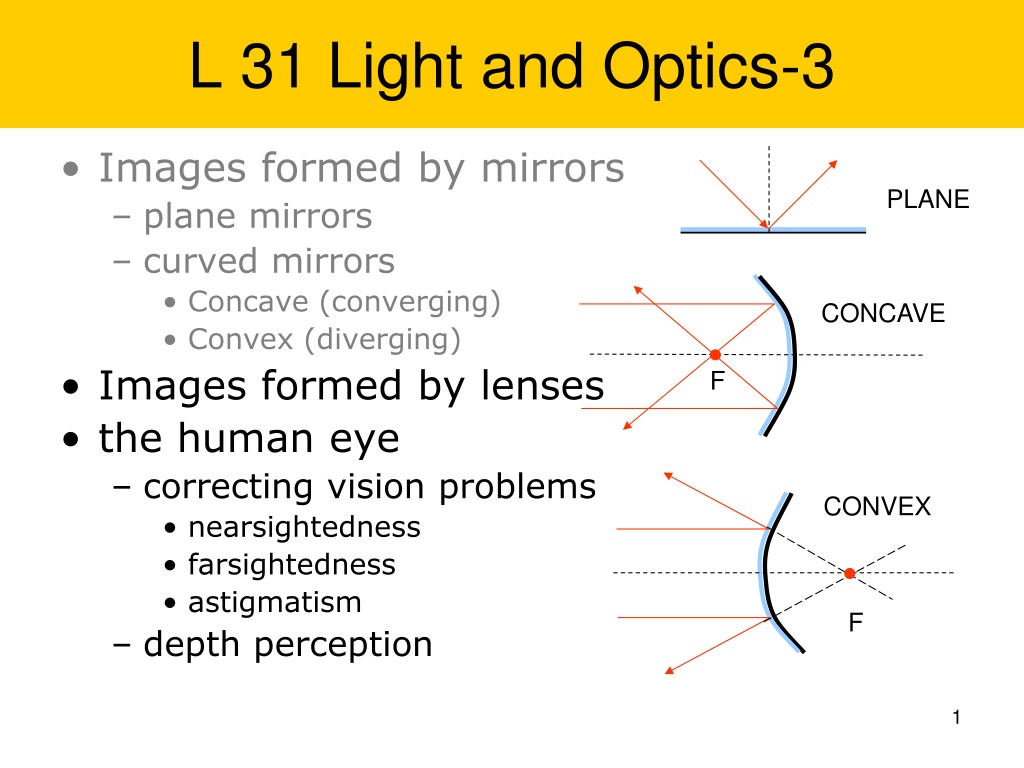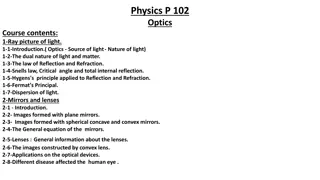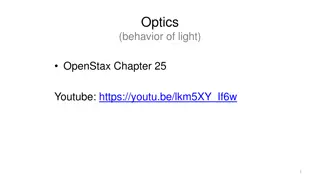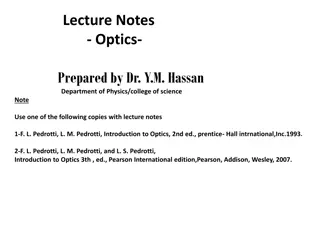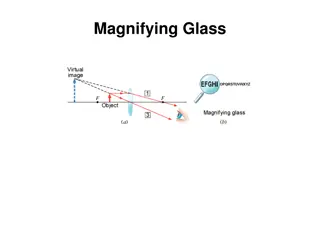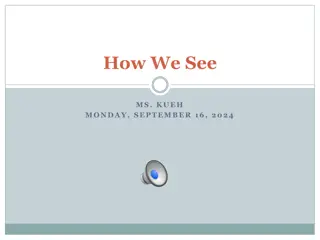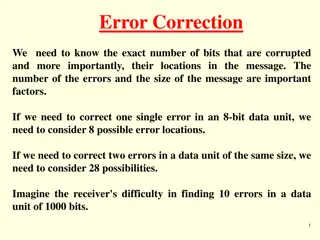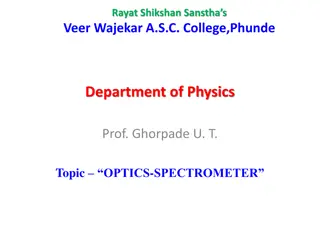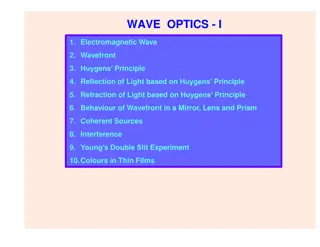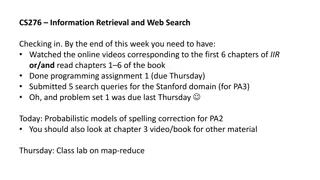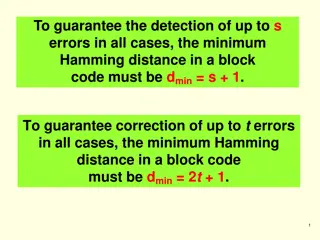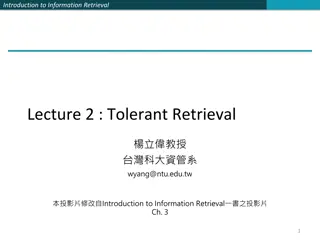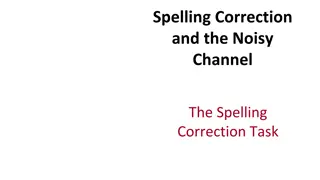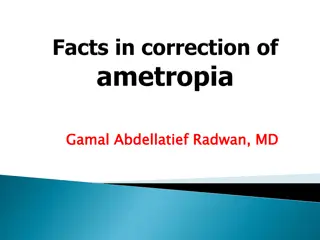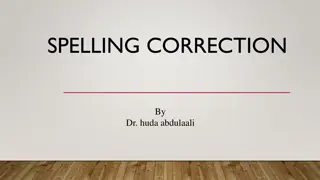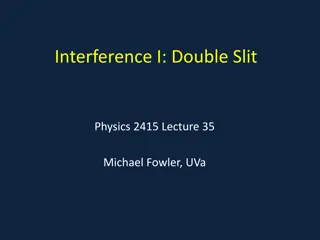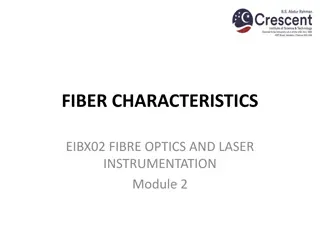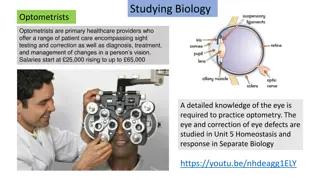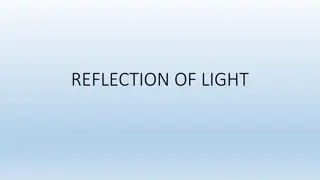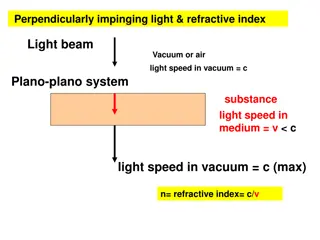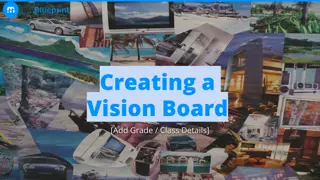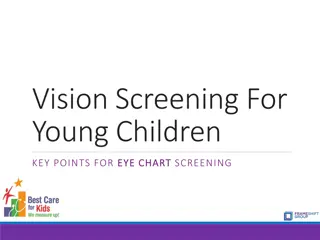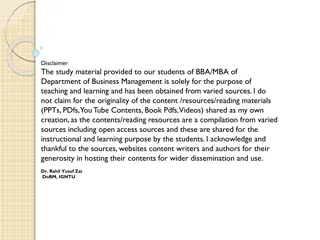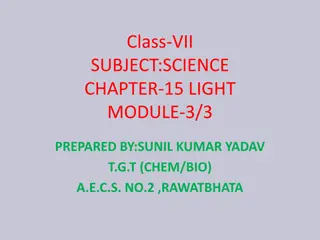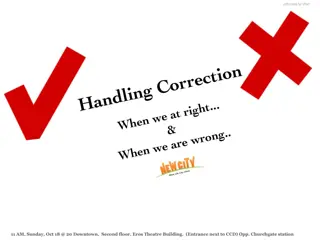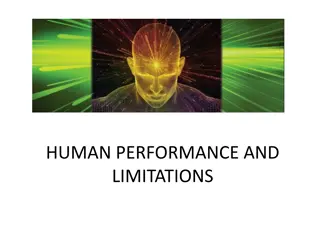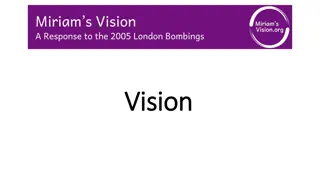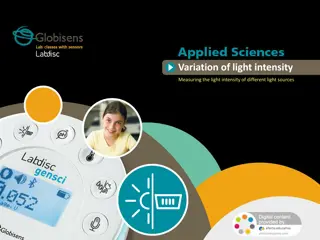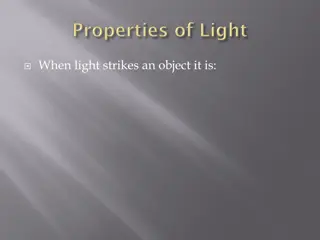Exploring Light, Optics, and Vision Correction
Understanding images formed by mirrors, lenses, and the human eye in the context of light and optics. Covering concepts like reflection, refraction, concave and convex mirrors, types of lenses, correcting vision issues, and laws governing the behavior of light.
Uploaded on Sep 21, 2024 | 0 Views
Download Presentation

Please find below an Image/Link to download the presentation.
The content on the website is provided AS IS for your information and personal use only. It may not be sold, licensed, or shared on other websites without obtaining consent from the author. Download presentation by click this link. If you encounter any issues during the download, it is possible that the publisher has removed the file from their server.
E N D
Presentation Transcript
L 31 Light and Optics-3 Images formed by mirrors plane mirrors curved mirrors Concave (converging) Convex (diverging) Images formed by lenses the human eye correcting vision problems nearsightedness farsightedness astigmatism depth perception PLANE CONCAVE F CONVEX F 1
Review-Law of reflection angle of incidence = angle of reflection R PLANE angle of reflection normal line angle of incidence 90 I Each segment of a curved mirror is a plane mirror. R I I R CONVEX 2 CONCAVE
Review VIRTUALimage: light rays appear to come from a point where there is no light REALimage: light rays actually converge at the image location PLANE MIRROR Image is VIRTUAL Same size as object Upright Same distance behind mirror OBJECT IMAGE CONCAVE MIRROR Image is REAL Inverted smaller than object OBJECT IMAGE 3
Image formation with lenses lenses are relatively simple optical devices the principle behind the operation of a lens is refraction: the bending of light as it passes from air into glass (or plastic) converging lens (positive lens) diverging lens (negative lens) the human eye correcting for nearsightedness correcting for farsightedness optical instruments 4
Refraction (bending) depends upon the index of refraction, n The refracted ray is bent away from the direction of the incident ray, toward the normal line. The larger the value of n, the more the ray is bent. Refracted ray Normal line Material of Index of refraction, n Incident ray There is a rule (Snell s Law) for calculating the angle of refraction given the angle of incidence. 5
A flat (sides are parallel) piece of glass does not make a lens Refraction occurs at surfaces 1 and 2 At surface 1, the ray is bent toward the normal At surface 2, the rays are bent away from the normal The rays emerging from surface 2 are parallel to the incident rays but displaced The rays are neither converging or diverging, so this does not form a lens 1 2 6
converging lens: thicker in middle focal point F A converging lens focuses parallel rays to a point called the focal point. A thicker lens has a shorter focal length. 7
Diverging lens: thicker at edge F A diverging lens causes parallel rays to diverge as if they came from a focal point F 8
Refraction at a curved surface Converging lens Diverging lens 9
Refraction at a curved surface F The red lines represent an approximation to the actual lens. Each ray hits the surface at a different angle of incidence because the normal lines are all different. Thus each ray is bent differently but all converge to a single focal point F. 10
Image formation by a converging lens image 2F F object If the object is located at a distance of at least 2F from the lens, the image is inverted and smaller than the object. The image is called a REAL image since light rays actually converge at the image location 11
A converging lens is used to focus rays from the sun to a point since the sun is very far from the lens, the rays are nearly parallel 12
a converging lens is used in a camera to focus light onto the film when you focus a camera, you adjust the distance between the lens and the film depending on the object location. 13
Image formation by a diverging lens image Object The diverging lens produces an image that is upright and diminished in size. It is a VIRTUAL image, since light rays do not actually pass through the image point 14
a magnifying lens F F object virtual image By placing the lens close to the object (image is within the focal length) a magnified virtual image is formed. 15
Vision the human eye Physics of the human eye Abnormal vision Nearsightedness Farsightedness astigmatism Depth perception 16
The Eye light enters through the cornea the iris controls the amount of light that gets in, a muscle can close it or open it; the iris determines your eye color the lens is filled with a jelly-like substance; the ciliary muscle can change the shape of the lens and thus change its focal length by changing the focal length, (accommodation) the lens is able to focus light onto the retina for objects located at various distances 17
the physics of the human eye Normal vision The relaxed eye can easily focus on distant objects. To focus on close objects, the lens is squeezed to shorten it s focal length, allowing the rays to converge on the retina. The near point is the distance at which the closest object can be seen clearly. The near point recedes with age. 18
Corrective lens for a nearsighted person When a nearsighted person views a distant object, the lens cannot relax enough to focus at the retina. The rays converge too quickly. The remedy is to place a diverging lens in front of the eye to first diverge the rays before they enter the eye. 19
Corrective lens for a farsighted person When a farsighted person tries to focus on a close object the lens cannot be squeezed enough to focus on the retina. The focus point is behind the retina. The remedy is to place a converging lens in front of the eye to converge the rays before they enter the eye. 20
How does the eye judge distance? Right eye D B Left eye Our brain interprets the images formed on the retinas of both eyes as a single image this is called binocular vision Our eyes roll inward slightly to focus on the distant point D. Our brain interprets the distance BD by the muscular effort required to roll the eyes inward. 21
Astigmatism With astigmatism the cornea is oval like a football instead of spherical like a basketball. This causes light to focus on more than one point in the eye, resulting in blurred vision. It can be corrected with specially shaped lenses or, in extreme cases, with surgery 22
